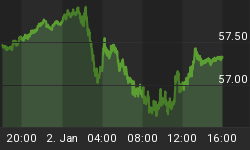Politicians and central bankers are desperately trying to convince investors that the economy has returned to what they deem as a "pre-crisis normality". But the truth is the global economy has never been in a more fragile condition. In an example of just how precarious the Fed-engineered asset bubbles have become, all of the 2014 U.S. equity market gains were wiped out by just a few really bad trading days in October.
That's correct, the Dow Jones, S&P 500 and the NADAQ averages were all negative after the first 10 months of last year. Investors were better off sitting on the sidelines in cash, waiting for the better entry point that appeared in mid-October. The so described strength of markets and the economy is completely illusory.
Investors need to strategically allocate their portfolios for volatility like we've never seen before, because government manipulations of formerly-free markets have caused equities to repeatedly lose half their value. That's what happened in 2000 and in 2008-'09. We are due for just such another crash in the very near future. The investing rollercoaster ride that results from the building and busting of asset bubbles is becoming more extreme as central bank intervention grows ever more intrusive.
We have now reached the point where central banks can never stop buying bonds because they cannot risk the normalization of interest rates. The best example of this is Japan. Allowing interest rates to mean revert would now cause nearly all of Japanese government revenue to be used for debt service. Once a market becomes aware that all of a nation's revenue must be used to pay interest on current outstanding debt, it becomes a mathematical certainty that it must default on the principal. This condition has always led to a currency, bond, equity and economic crises.
Throughout economic history this has only really occurred in isolation, and/or in small banana republics. However, presently most major economies face the same fate concurrently. Japan, China, Europe and the United States cannot allow rates to rise...ever.
It seems logical to conclude that eventually the money printers will become successful. After all, if buying banks' assets doesn't boost the money supply central banks could simply resort to writing checks directly to the public. By circumventing the private banking system it would guarantee to create the inflation that money printers so desire. And then, once inflation runs out of control and asset bubbles grow to unimaginable heights, interest rates MUST become unglued because investors will then lose complete confidence in all fiat currencies. Insolvency can be the only result of interest rate normalization and that is why central banks will fight it until the end.
Nevertheless, on the journey to central banks' ultimate solution to create runaway inflation, it seems deflation has once again become the main issue. This happens every time the Fed has tried to stop its QE programs. That deflation is now pervading across the entire globe.
The perma-bull bobble heads in the financial media are extolling plunging oil prices as the consumers' panacea. But the drop in oil also happens to coincide with cascading base metal prices and global bond yields that are crashing through the floor. Perhaps this is because nearly every economy on the planet is either flirting with, or in a recession. Sure, deflation is great for the consumer in the long run. But the collapse of asset bubbles, although healthy and necessary, never feels great on the way down. Crumbling equity markets and falling home prices, along with rising unemployment rates and recessions aren't going to be offset by a few extra bucks in your pocket at the pump. The WTI crude oil price at $33 per barrel didn't immediately bail out the consumer in March of 2009, and it won't save them this go around either.
In fact, the only vibrant growth that can be found anymore in the world is in the Bank of Japan's balance sheet--and in government debt levels--not in global GDP. The true message of falling oil prices is that global economic growth is headed towards the zero bound range and deflation will be the prevalent condition in the short term. Why else would the German 5-year note offer investors a negative yield? The current state of record low and negative bond yields are a sign of economic chaos, not a return to normality.
Investors would be very foolish to contend the U.S. can remain unscathed from this global deflation and recession. The market selloff that began in early 2015 is the result of slowing economic data, which is beginning to unwind the massive yen carry trade.
But deflation has become public enemy number one in the eyes of all central bankers. Therefore, it would be even more foolish to believe that the Federal Reserve will raise interest rates into this incipient deflation and recessionary environment. To the contrary, the printing presses for QE IV are already warming up and the big shock of 2015 will be the rebound of investments that profit from a weakening U.S. dollar.
The Fed believes interest rate normalization can occur within the context of robust economic growth. However, a pivot away from the inflationary monetary policy of the last 6 years will only start the rollercoaster down the cliff towards a deflationary depression.
















